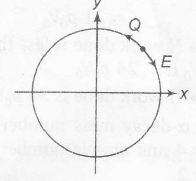Answer:
Option B
Explanation:
$\frac{M}{L}=\frac{Q}{2m}$

$\therefore$ $M=(\frac{Q}{2m})L$
$\Rightarrow$ $ M\propto L,$ where $ \gamma=\frac{Q}{2m}$
$=\left(\frac{Q}{2m}\right)(l\omega)$
$=\left(\frac{Q}{2m}\right)(mR^{2}\omega)=\frac{Q\omega R^{2}}{2}$
Induced electric field is opposite.
Therefore $\omega'=\omega-\alpha t$
$\alpha=\frac{\tau}{I}=\frac{(QE)R}{mR^{2}}=\frac{(Q)(\frac{BR}{2})R}{mR^{2}}=\frac{QB}{2m}$
$\therefore$ $\omega'=\omega-\frac{QB}{2m}.1=\omega-\frac{QB}{2m}$
$M_{f}=\frac{Q\omega' R^{2}}{2}=Q(\omega-\frac{QB}{2m})\frac{R^{2}}{2}$
$\therefore$ $\triangle M=M_{f}-M_{i}=-\frac{Q^{2}BR^{2}}{4m}$
$M=-\gamma \frac{QBR^{2}}{2}$ $(as\gamma=\frac{Q}{2m})$